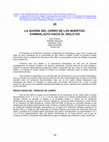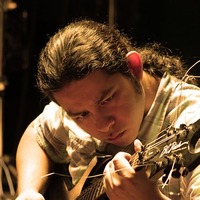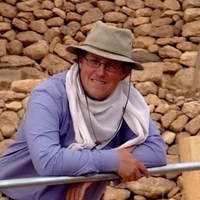Papers by Camilo Alejandro Luin

Itzimte (municipio La Libertad, Department of Peten, Guatemala) is a medium-sized Maya site in th... more Itzimte (municipio La Libertad, Department of Peten, Guatemala) is a medium-sized Maya site in the savanna region in Central Peten. It was first described by Theobert Maler in 1908 and later visited by Sylvanus Morley in 1915 and 1921. In 2002 it was studied by Atlas Arqueologico de Guatemala team leaded by Hector Mejia. Itzimte consists of 6 principal plazas and 16 dispersed patio groups occupying about 50 ha. Monumental corpus of the site included 20 stelae (10 carved) and 12 altars (4 carved). During the fieldwork of the Atlas Epigrafico de Peten project from 2013 to 2016 we redocumented major part of Itzimte hieroglyphic inscriptions. Dynastic count recorded on Stela 7 implies that the ruling house of Itzimte was founded in the beginning of the Early Classic period. Although later Early Classic (250-600 AD) history is unknown, we identified names of Late Classic rulers. Late development of Itzimte comparing to other neighboring polities seems to be related to its alliance with Ik'a (Motul de San Jose) kingdom around 760-770 AD.

Itzimte (municipio La Libertad, Department of Peten, Guatemala) is a medium-sized Maya site in th... more Itzimte (municipio La Libertad, Department of Peten, Guatemala) is a medium-sized Maya site in the savanna region in Central Peten. It was first described by Theobert Maler in 1908 and later visited by Sylvanus Morley in 1915 and 1921. In 2002 it was studied by Atlas Arqueologico de Guatemala team leaded by Hector Mejia. Itzimte consists of 6 principal plazas and 16 dispersed patio groups occupying about 50 ha. Monumental corpus of the site included 20 stelae (10 carved) and 12 altars (4 carved). During the fieldwork of the Atlas Epigrafico de Peten project from 2013 to 2016 we redocumented major part of Itzimte hieroglyphic inscriptions. Dynastic count recorded on Stela 7 implies that the ruling house of Itzimte was founded in the beginning of the Early Classic period. Although later Early Classic (250-600 AD) history is unknown, we identified names of Late Classic rulers. Late development of Itzimte comparing to other neighboring polities seems to be related to its alliance with Ik'a (Motul de San Jose) kingdom around 760-770 AD.
XXXIV Simposio de Investigaciones Arqueológicas en Guatemala, 2021
Recent finds and research concerning objects made from travertine have revealed new information i... more Recent finds and research concerning objects made from travertine have revealed new information in the field of epigraphic studies. Few hieroglyphic texts carved on that material have been discovered; these constitute a limited corpus among the inscriptions from the western Maya lowlands. The vessel presented in this paper is the longest example known to this date and contains a mythological text dealing with fire rituals aiming at securing the continuity of time, carried out during the las five days of the year in the month called wayeb.
XXXI Simposio de Investigaciones Arqueológicas en Guatemala 2017, tomo 2. Ministerio de Cultura y Deportes, Instituto de Antropología e Historia, Asociación Tikal, 2018
XXXi SimpoSio de inveStigacioneS aRqueológicaS en guatemala muSeo nacional de aRqueología y etnol... more XXXi SimpoSio de inveStigacioneS aRqueológicaS en guatemala muSeo nacional de aRqueología y etnología 17 al 21 de julio de 2017 EditorEs BárBara arroyo luiS méndez SalinaS Gloria ajú álvarez
XXXI Simposio de Investigaciones Arqueológicas en Guatemala 2017, tomo 2. Ministerio de Cultura y Deportes, Instituto de Antropología e Historia, Asociación Tikal, 2018
XXXi SimpoSio de inveStigacioneS aRqueológicaS en guatemala muSeo nacional de aRqueología y etnol... more XXXi SimpoSio de inveStigacioneS aRqueológicaS en guatemala muSeo nacional de aRqueología y etnología 17 al 21 de julio de 2017 EditorEs BárBara arroyo luiS méndez SalinaS Gloria ajú álvarez
Ponencia presentada en el XXIV Simposio de investigaciones arqueológicas de Guatemala, Museo naci... more Ponencia presentada en el XXIV Simposio de investigaciones arqueológicas de Guatemala, Museo nacional de Etnología y Arqueología, Julio 2010
XXIX Simposio de Investigaciones Arqueológicas en Guatemala 2014, tomo 2, 2016
Anales de la Academia de Geografía e Historia de Guatemala, tomo XC (2015).
Anales de la Academia de Geografía e Historia de Guatemala, tomo XC (2015).
Second season of the project "Atlas Arqueológico de Petén" was realized in April and May 2014. lt... more Second season of the project "Atlas Arqueológico de Petén" was realized in April and May 2014. lt was oriented to the documentation and analysís of the giant hieroglyphic inscription on the roofcomb and facade of the Temple VI or Temple of the Inscriptions (Str. 6F-27), Tikal.
Presentation of a circular altar from the Yaxchilan region and a discussin of its hieroglyphic in... more Presentation of a circular altar from the Yaxchilan region and a discussin of its hieroglyphic inscription. The scene on the altar shows the delivery of captives to Yaxchilan's Shield Jaguar II, although the altar was carved during the reign of Bird Jaguar IV.

El Programa de Evaluación, Inventario y Diagnóstico de Kaminaljuyu surge como un apoyo por parte ... more El Programa de Evaluación, Inventario y Diagnóstico de Kaminaljuyu surge como un apoyo por parte de cinco estudiantes de la Universidad de San Carlos al IDAEH, siendo el propósito recabar información sobre la condición del sitio para el año 2002, la cual ayudará a tomar las medidas necesarias para su protección. Podemos decir que debido a su importancia Kaminaljuyu ha sido foco de diversas investigaciones de carácter científico y de rescate y salvamento. Resumir cada uno de estos trabajos o explicar los diversos planteamientos propuestos sobre el desarrollo del sitio, sería un tema demasiado amplio y el enfoque de nuestro trabajo es mostrar los resultados obtenidos sobre el estado actual de conservación del sitio. Para nosotros lo importante no es solo describir las condiciones en que se encontró Kaminaljuyu, sino es encontrar una solución viable para la protección del sitio. Desdichadamente el espacio no permite describir todos los montículos documentados, cada uno de los cuales reflejan situaciones muy particulares que deben ser tomadas en cuenta para una posible intervención, por lo que en forma general se dan conocer los resultados obtenidos del trabajo de campo realizado entre diciembre del 2001 y enero del 2002.
Quirigua is one of the Maya cities that presents the greatest intellectual development. Evidence ... more Quirigua is one of the Maya cities that presents the greatest intellectual development. Evidence for this is the high level of complexity and detailed captured in its altars, stelae, and zoomorphs. During the last two years, the Mosaic documentation Program of Quiriguá Park has had the task of protecting, organizing, and cataloguing the many fragments of sculpture that until now have been forgotten in the bodega at the site. During this process, 51 hieroglyphic blocks from the middle cornice of Structure 1B-1 have been located, 35 of which have not yet been published. In this opportunity, we present an epigraphic interpretation of these blocks, trying to integrate them into the rest of the narrated passage depicted on
the hieroglyphic benches of this structure with the objective of filling in the historical gaps that have remained in obscurity.
NOTES ON SOME HIEROGLYPHIC TEXTS IN PRIVATE COLLECTIONS Who will be able to read them? These were... more NOTES ON SOME HIEROGLYPHIC TEXTS IN PRIVATE COLLECTIONS Who will be able to read them? These were the words of John Lloyd Stephens upon seeing Maya hieroglyphs in 1840. Over the last decades, decipherment of Maya writing has advanced impressively, this thanks to the large quantity of preserved texts. While some investigators do not agree with the study of unprovenienced artifacts, there is no doubt that this source has provided many clues on innumerable aspects of Maya history, mythology, iconography, and epigraphy. In this work we present the epigraphic analysis of two stela fragments and a polychrome bowl, all with Wayob' representations, which come from private collections in Guatemala.











Uploads
Papers by Camilo Alejandro Luin
the hieroglyphic benches of this structure with the objective of filling in the historical gaps that have remained in obscurity.
the hieroglyphic benches of this structure with the objective of filling in the historical gaps that have remained in obscurity.
During the fieldwork of the Atlas Epigrafico de Peten project from 2013 to 2016 we redocumented major part of Itzimte hieroglyphic inscriptions. Dynastic count recorded on Stela 7 implies that the ruling house of Itzimte was founded in the beginning of the Early Classic period. Although later Early Classic (250-600 AD) history is unknown, we identified names of Late Classic rulers. Late development of Itzimte comparing to other neighboring polities seems to be related to its alliance with Ik'a (Motul de San Jose) kingdom around 760-770 AD.